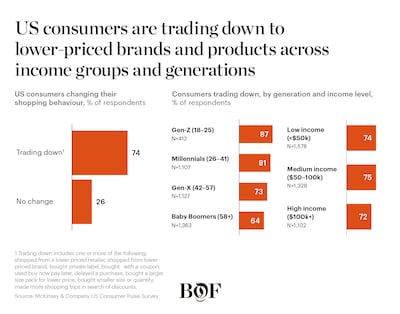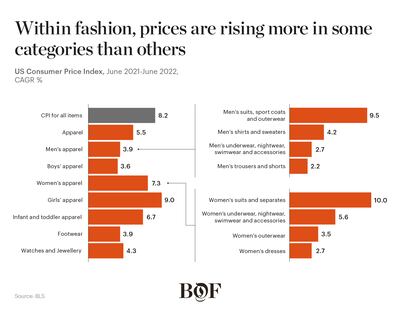
The Business of Fashion
Agenda-setting intelligence, analysis and advice for the global fashion community.

Agenda-setting intelligence, analysis and advice for the global fashion community.

 Opens in new window
Opens in new windowIndustry earnings statements over the recent period have made for bleak reading. Cost pressures have impacted nearly all categories, putting increased pressure on margins and volume, and making any return to pricing “normalcy” feel far off. Indeed, secondary effects mean prices are rising through the value chain, and wages are following suit — in the US they are rising twice as fast as in 2019. Meanwhile, consumers are drawing back. McKinsey’s most recent Consumer Pulse Survey shows 37 percent of consumers plan to reduce discretionary spending and 74 percent say they are trading down when shopping.
For most fashion companies, inflation is top of their list of concerns for 2023. However, they also understand that change does not happen easily or overnight. With buying and merchandising cycles stretching to 18 months in some cases, decision makers need to think carefully about how to plan for secondary effects and manage their margin structures over time. Those that act robustly have an opportunity to establish a durable advantage against their competitors. Conversely, a tepid response is likely to lock in a multi-year cycle of margin erosion and underperformance.
While inflation has near-universal impacts, the specific challenges facing fashion players often reflect their regional exposures and business models. In the US, for example, the Federal Reserve has taken an aggressive approach to taming inflation, with the Federal Reserve’s key rate expected to rise above 4.5 percent in 2023. Moreover, private sector wage growth has been stronger than in other regions, suggesting inflation may prove sticky in the longer term. In Europe, by contrast, inflation is being driven by energy prices, and may therefore resolve more easily once the impacts of the war in Ukraine abate. Still, currency fluctuations are likely to continue to affect companies with costs in US dollars and sales in euros.
Asia is an outlier in the global context, in that a relatively benign inflation environment is being offset by slow growth and the continuation of Covid-related economic impacts, particularly in China. However, the region’s financial health is being undermined by rising US interest rates and high commodity prices. Meanwhile, Latin America presents a mixed picture, with some countries putting in place an aggressive monetary response to inflationary risk, while others remain in relatively good shape.
ADVERTISEMENT
The challenging economic environment has had asymmetric impacts across fashion business models. However, in general, businesses with the highest exposures to disposable income are facing the biggest challenges.
In the luxury and affordable luxury segments, many well-known brands have remained insulated, or partially insulated, from the impacts of inflation and macroeconomic turbulence. LVMH, which owns brands including Christian Dior, Fendi and Givenchy, reported organic 20 percent revenue growth to €56.5 billion (approximately $55.8 billion) in the first nine months of 2022, compared to a year earlier.
Among premium brands, the picture is mixed. Value-conscious consumers are trading down into value, off-price and private label brands, while higher-income consumers are less likely to switch. As highlighted in recent US earnings calls, the environment is particularly tough for companies that have overbought inventory and are contending with supply chain issues. This has led in some cases to declines in gross margins and a wave of discounting.

As consumers trade down, the value segment may benefit. Indeed, retailers can optimise their propositions by shifting away from brand-name products and toward more private-label offerings. In addition, an agile approach to product design can be a winning strategy, allowing manufacturers to reset their cost bases and cater to shifts in consumer demand, albeit with a delayed impact on the bottom line. Similarly, the discount segment is well placed to navigate the current environment. The strongest demand is likely to be from lower-income consumers, who will feel the impacts of inflation more than their peers. Moreover, off-price retailers will benefit by picking up low-cost inventory from under-pressure retailers further up the food chain.

While inflation is running at the fastest rate for decades, and consumer sentiment remains subdued, fashion companies are well-placed to take action that could offset pressure on performance. Here we gather six ideas that leading businesses have harnessed to optimise their approaches:
Triple your productivity effort: Amid pervasive price rises through the value chain, productivity will be a key success factor. Players should conduct a rigorous assessment of input costs and double down on indirect spend and organisational efficiencies to maximise productivity. Leading manufacturers are also resetting their cost bases through design-to-value thinking. Meanwhile, suppliers and vertically integrated players can recalibrate their supply and distribution networks. A third option is to relocate distribution centres to balance labour economics with last-mile costs, or use third-party logistics and supply-chain-as-a-service providers to reduce asset intensity and distribution overheads.
Reset your assortment and category strategy: Consumers are letting their wallets do the talking. In the early months of 2022, 67 percent of consumers that tried a new brand cited value as a reason for switching, an increase of 9 percentage points from October 2020. Meanwhile, about a third of consumers have switched to a private label brand over the past year. Fashion players can respond to these trends by revising their assortments and sharpening entry-level price points. Retailers, meanwhile, can extend private-label offerings. Winners will also leverage data and analytics capabilities to work out where consumers are most price sensitive and which segments are the most exposed to inflation. Looking ahead, retailers seeking to improve private-brand penetration could foster awareness and loyalty by adopting consumer-led brand strategies and category management, as well as ramping up design capabilities.
Surgically rebase your value equation: Instead of implementing broad price increases that erode customer trust, retailers could reprice by customer and product segment, taking into account both margin performance and willingness to pay. In parallel, they could introduce personalised promotions and loyalty initiatives, especially for products that are highly exposed to inflation or are important to customers. This can strengthen relationships while alleviating margin pressure by reducing the need for mass promotions. Fashion players that take a surgical approach to these endeavours are more likely to emerge with profitability and consumer relationships intact. In addition, to win or retain near-term market share, businesses may consider absorbing some higher costs.
ADVERTISEMENT
Consider adjusting discounts and promotions: Several leading players are re-evaluating their pricing and promotion mixes, helping them manage volatility without punishing consumers. In addition, forward-looking companies have shown that data and analytics can help them become more precise in their efforts, as well as more effective in managing inventory surplus, value perception and margins. There is also an opportunity to better manage attributes that the data reveals are valuable to consumers.
Reimagine your labour model: To counter the effects of labour cost inflation, retailers could look for opportunities across their business model. These may comprise deploying more technology and analytics, resetting labour allocation, reviewing scheduling and taking an end-to-end approach to managing costs. Half of US retail employees are considering leaving their jobs, a much higher proportion that in the wider economy. Therefore, it makes sense to invest in the frontline employee experience, leveraging recruitment and talent analytics to beef up capabilities, and refreshing ideas that could encourage staff to remain in their jobs.
Scale up management capacity and decision making: In a challenging macroeconomic environment, executive teams have a vital role to play. This is an ideal time for decision makers to remove bottlenecks and streamline communications and workflows with vendors, supply teams, design teams, and store and e-commerce operatives. Tactically, this could mean improving visibility into cost structures and strategically communicating across the organisation — and with vendors and suppliers. By accelerating decision making, fashion players can focus minds on delivering pricing that achieves the highest return on investment, especially when responding to competitor moves. Accordingly, leaders need to define KPIs that both track customer behaviours and measure the effectiveness of initiatives. For instance, by carefully monitoring product categories for declining volumes and basket size, they can spot signs of behaviour changes caused by price sensitivity.
Inflation and economic uncertainty are powerful drivers of fashion industry performance, and are unlikely to abate anytime soon. Therefore, the task for decision makers over the coming months will be to impose short-term tactical discipline on business models, but at the same time embed strategies that promote flexibility, clarity and fast decision making across geographies and operations.
Emily Reasor is a senior partner in McKinsey’s Denver office, leads McKinsey’s Retail and Growth, Marketing and Sales practices, and leads the Pricing and Margin Management service line for the Americas. Aaron Rettaliata is a partner in McKinsey’s Pittsburgh office, leads McKinsey’s Retail and Consumer Goods practice and leads the Merchandising service line in North America. Jesse Nading is an associate partner in McKinsey’s Denver office and is a leader in McKinsey’s Retail practice, with expertise across growth and commercial topics for apparel, fashion, food and specialty retail. Jad Hamdan is an engagement manager in McKinsey’s Denver office and specialises in commercial retail topics among fashion and specialty retail players, including growth transformation, pricing and promotions.
The authors would like to thank Felix Rölkens, Kevin Bright, Andres Moinge, Gokmen Ciger, Claus Heintzeler and Sarah André for their contribution to this article.
This article first appeared in The State of Fashion 2023, an in-depth report on the global fashion industry, co-published by BoF and McKinsey & Company.
 Opens in new window
Opens in new windowThe seventh annual State of Fashion report by The Business of Fashion and McKinsey & Company reveals the industry is heading for a global slowdown in 2023 as macroeconomic tensions and slumping consumer confidence chip away at 2022′s gains. Download the full report to understand the 10 themes that will define the industry and the opportunities for growth in the year ahead.
This week’s round-up of global markets fashion business news also features Latin American mall giants, Nigerian craft entrepreneurs and the mixed picture of China’s luxury market.
Resourceful leaders are turning to creative contingency plans in the face of a national energy crisis, crumbling infrastructure, economic stagnation and social unrest.
This week’s round-up of global markets fashion business news also features the China Duty Free Group, Uniqlo’s Japanese owner and a pan-African e-commerce platform in Côte d’Ivoire.
Affluent members of the Indian diaspora are underserved by fashion retailers, but dedicated e-commerce sites are not a silver bullet for Indian designers aiming to reach them.